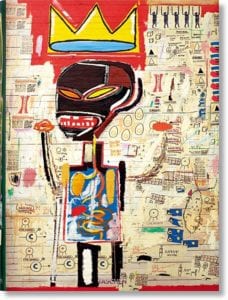
by Dieter Buchhart
In 1984, Basquiat began to collaborate intensely with Andy Warhol. The partnership was originally proposed by influential art dealer Bruno Bischofberger, Basquiat’s European gallerist. In 1984 and 1985, Basquiat produced fifteen joint works with Warhol and Francesco Clemente, and more than 140 collaborations with Warhol; these comprise more than one-tenth of Basquiat’s painterly oeuvre. [Keith] Haring describes the collaboration as “a kind of physical conversation happening in paint instead of words.” Basquiat accentuated and replaced Warhol’s creations with his own visual elements: as Haring recalls, “Andy loved the energy with which Jean-Michel would totally eradicate one image and enhance another….They worked on many [canvases] at the same time, each idea inspiring the next. Layers and layers of images and ideas would build towards a concise climax.” While Warhol, inspired by Basquiat, returned to his painterly beginnings, Basquiat began to sample from his own collages using silkscreening.
The thematic horizon of the collaborations is broad; the works engage with every-day racism, encounters between different cultures and capitalist consumer society in a number of ways. It was a meeting of two opposites, two different world views: while Basquiat explicitly critiqued capitalism, Warhol seemed to embody the role of the artist as businessman. Warhol tore down all barriers between business and art, adopting the rules of industrial society, calling his studio “The Factory” and giving the impression that he produced art on an assembly line. But did he glorify modern consumer goods in order to affirm the capitalist marketplace or to lambaste the represented and lived world of consumption? The image of Warhol as a star artist is now understood as a mask that, like his silkscreens, reflects the mechanisms of modern capitalist consumer society. Basquiat, on the other hand, clearly expressed his stance against capitalism in a number of the artists’ collaborative works.
Such collaborations became an exciting, critical dialogue between two greats of American art history. In 1985, however, following a devastating review of an exhibition of sixteen joint works at the Tony Shafrazi Gallery, Basquiat abruptly ended the productive collaboration.
From Jean-Michel Basquiat: Now’s the Time by Dieter Buchhart, Prestel, prestel-usa.com. Reprinted with permission. All rights reserved.
